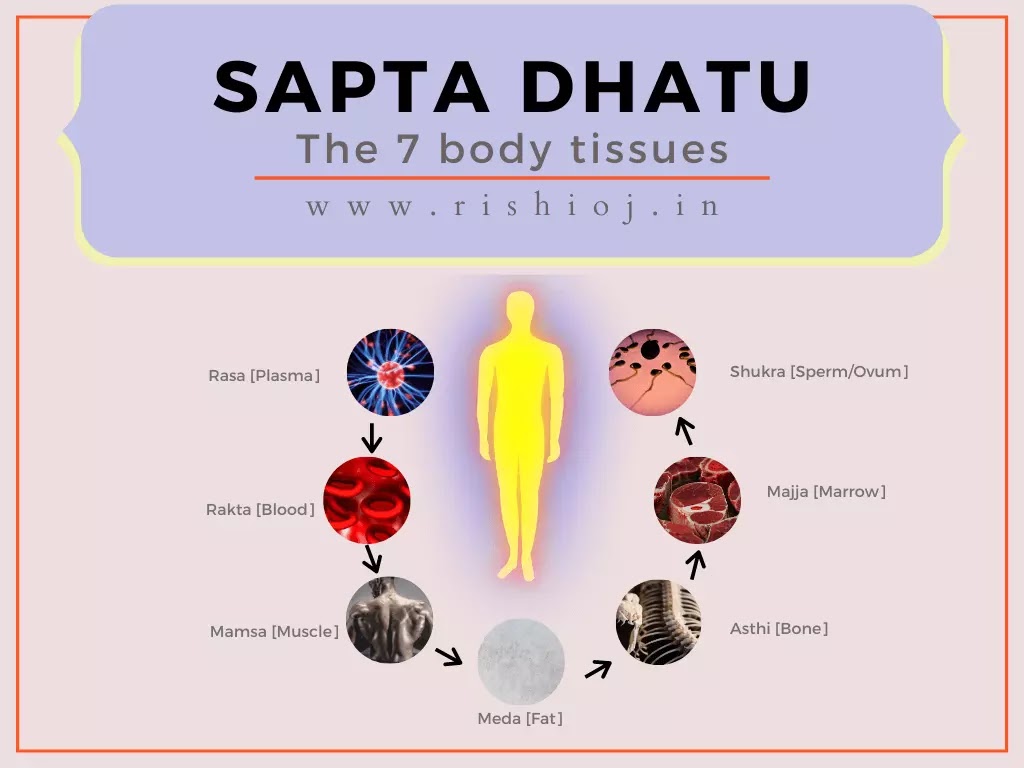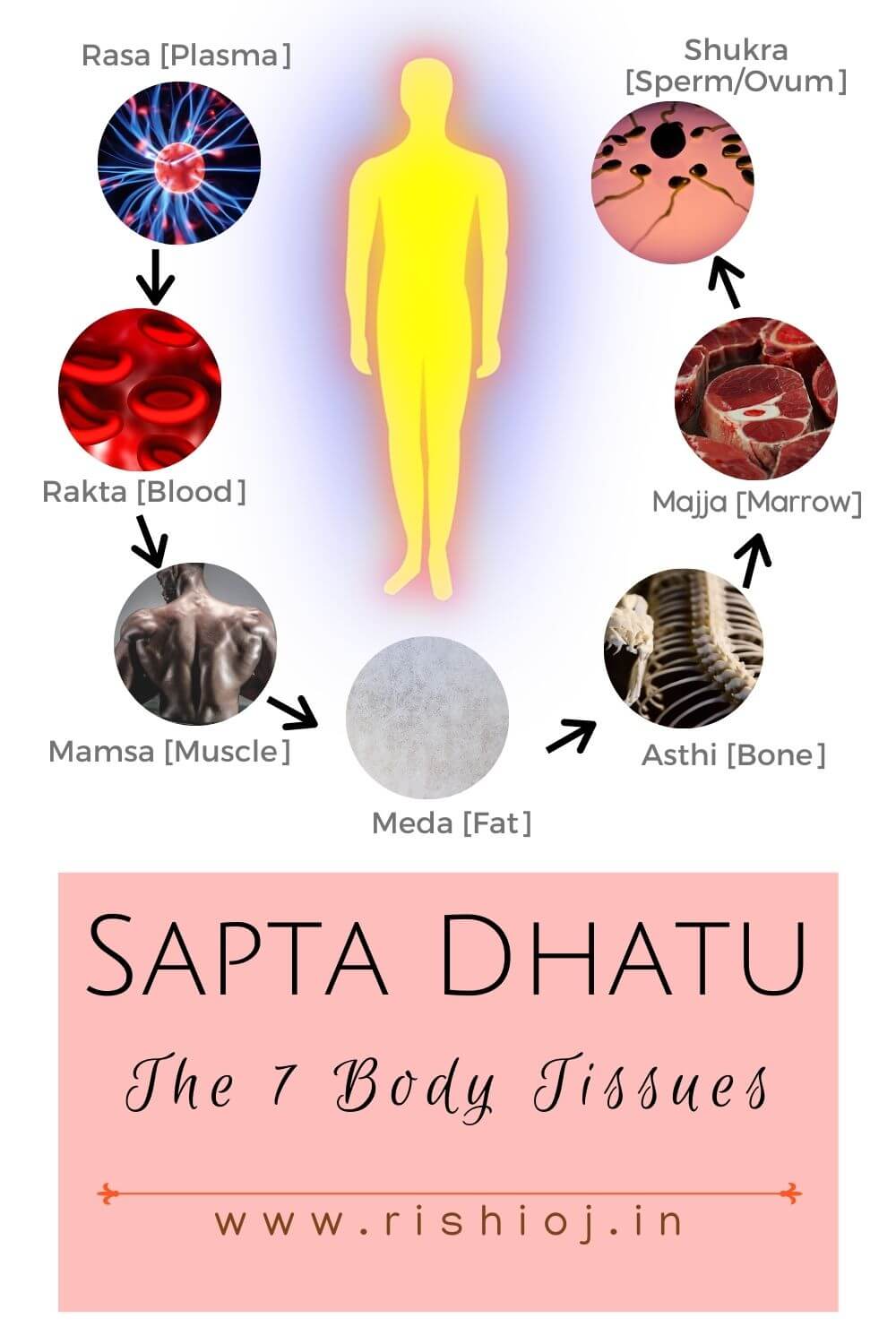What does Dhatu mean?
What are Sapta dhatus?
The saptadhatus can be called the building blocks of the body. They are:
i. Rasa (Plasma)
ii. Rakta (blood):
iii. Mamsa (muscle)
iv. Meda (Adipose tissue)
v. Asthi (bones and Cartilage)
vi. Majja (bone marrow)
vii. Shukra (Reproductive fluid )
Origin and formation of Dhatu
The food which we intake is digested, absorbed and assimilated by the bioenergy of the body called Agni. The most important Agni is Jatharagni which when works upon the ingested food, converts it into two parts: Saar and Mala.
1. Saar: Saar contains all the nutrients and energy which after various processes converts into dhatu.
2. Mala: Mala or Trimalas are the undigested waste matter of the body which is discarded.
Formation of Sapta dhatus can be compared with the ecological food chain pyramid. As In food chain, the food energy passes from one trophic level to other, similarily the formation and health of one dhatu is dependent on the previous dhatu. Each Dhatu is formed with the combination of Panchamahabhuta (The five great elements)- Fire, water, earth,air, space and Tridosha- Vata, Pitta and Kapha- regulate the Dhatus. Each Dhatu nourishes and supports updhatu (sub-tissue or secondary tissue).
Nourishment of dhatu
Every dhatu has its own digestive fire (dhatvagni). Each dhatu gets digested by their respective dhatvagni and nutrients thus obtained helps to form the succeeding dhatu and sometimes updhatus too.
|
Each dhatu nourishes the next dhatu. i. Food nourishes Rasa ii. Rasa nourishes Rakta iii. Rakta nourishes Mamsa iv. Mamsa nourishes Meda v. Meda nourishes Asthi vi. Asthi nourishes Majja vii. Majja nourishes Shukra |
|
Overview of Saptadhatus:
1. Rasa Dhatu
Origin: It is first dhatu. It represents plasma. This dhatu is formed in the digestive system soon after digestion. It is formed from the essence of the food we ingest.
Quantity: 9 anjali
Function: It is major constituent of human body. Its main function is preenana, i.e. nourishment of all the tissues, cells and organs. It mainly nourishes and strengthens blood.
Predominating mahaboot: Jal mahabhuta (water)
Dominant Dosha: Kapha
Dhatvagni: Rasagni
Corresponding Updhatu: breast milk(Stanya), menstrual flow (Rajastrav)
Mala produced: Sweat, tears and saliva, cough
Symptoms of Increase in Rasa dhatu:
• weak digestion
• Vomitting
• Nausea
• Excess salivation
• breathing related problems
• cough
• excessive sleep
• sluggish digestion
Symptoms of Rasa deficiency:
• palpitation
• increase in heart beat
• pain in heart
• early exhaustion
• dryness in mouth and body parts
• thirst
• emaciation
• intolerance to sound
Diseases caused due to imbalancing of Rasa dhatu
• Poor appetite
• pigmentation
• wrinkles on face
• pain in body parts
• drowsiness
• tastelessness
• impotence
• lack of interest in the food
• fever
Treatment of Rasaj rog:
• fasting
• taking rasayan
• nourishment therapy (tarpan): for example, netra tarpan
• therapeutic emesis, vamana(vomiting)
2. Rakta Dhatu
Origin: Rakta dhatu is blood without plasma. This dhatu is formed by the nutrients present in Rasa dhatu.
Quantity: 8 anjali
Function: Its main function is jeevana, i.e. enlivening. It maintains life, transports oxygen to all the vital organs, clears complexion of skin, increases strength and immunity.
Predominating mahaboot: Agni and jal mahabhuta (fire and water)
Dominant Dosha: Pitta dosha
Dhatvagni: Raktagni
Corresponding Updhatu: Blood Vessels/vein (Shira), Fascia/Tendon (Kandara)
Mala produced: various pigments and acidic secretions
Symptoms of Increase in Rasa dhatu:
• Redness in skin
• Redness in eyes
• fullness of veins
Symptoms of Rasa deficiency:
• paleness in skin
• loss of lustre from hair
• weak blood vessels
• dryness and cracks in skin
• craving for sour and cold food items
Diseases caused due to imbalancing of Rasa dhatu:
Following disorders are caused due to blood vitiation:
• Anemia
• leprosy
• blood cancer
• bleeding disorder
• haematuria
• discoloration of skin
• state of confusion
• saline taste in mouth
• fetid odour in body
• foul smell in nose and mouth
Treatment of Rakta rog:
• purification of blood
• therapeutic purgation (virechana)
• bloodletting (rakta mokshana)
• pacification therapy (shamana)
• theraupetic fasting
3. Mamsa Dhatu
Origin: Mamsa dhatu represents the muscles. This dhatu gets nourishment from Rakta as well as Rasa dhatu.
Quantity: 3 anjali
Function: Its main function is lepana, i.e. protection and covering. It covers the delicate vital organs, enables movement and provides physical strength to the body.
Predominating mahaboot: vayu, jal and agni (air, water and fire)
Dominant Dosha: Kapha dosha
Dhatvagni: Mamsagni
Corresponding Updhatu: Muscle fat, skin
Mala produced: Earwax, mucus, eye discharges
Symptoms of Increase in Mamsa dhatu:
• thickness of buttocks, arms, thighs, cheeks
• heaviness of body
• extra muscular growth
Symptoms of Mamsa deficiency:
• loss in flesh of the buttocks, neck and abdomen
• fatigue
• dryness
• craving for sour and cold food items
Diseases caused due to imbalancing of Rasa dhatu:
• burning sensation in the body
• thirst
• swelling
• skin disorders
• tertiary fever
• piles
• inflammation of epiglottis
• obstinate urinary diseases
Treatment of Mamsa rog:
• fasting
• purification
• application of alkali
• cauterization
• enema therapy
4. Meda Dhatu
Origin: It indicates fat and adipose tissue of the body. This dhatu is formed by the nutrients present in Majja dhatu in addition to Rasa and Rakta dhatus.
Quantity: 2 anjali
Function: Its main function is snehana, i.e. lubrication. It maintains the lubrication of all the tissues. It provides insulation to the body and increases strength, stability and nourishment to bone tissue.
Predominating mahaboot: prithvi, jal and agni mahabuta (earth, water and fire)
Dominant Dosha: Kapha dosha
Dhatvagni: Medagni
Corresponding Updhatu: ligaments (snayu), joints (sandhi)
Mala produced: sweat, sebum
Symptoms of Increase in Meda dhatu:
• abdominal obesity
• unctuousness of body
• cough
• bad body odour
Symptoms of Meda deficiency:
• decreased abdominal girth
• exhaustion
• cracking sound in joints
• dryness and cracks in skin
• craving for fatty food
• weak muscles
Diseases caused due to imbalancing of Meda dhatu:
• obesity
• diabetes
• high cholesterol
• emotional disturbances
• numbness
• thirst
Treatment of Meda disorders:
• adopting healthy lifestyle
• regular yoga practices
• thrapatic fasting
• eating ghee, milk (in case of deficiency of meda)
5. Asthi Dhatu
Origin: It represents bones and cartilage. It is the hardest dhatu. This dhatu is formed from nutrients in Meda Dhatu in addition to Rasa, Rakta, and Mamsa.
Quantity: 206
Function: Its main function is dharana, i.e. to hold up body structure. It provides structure and support to the body. It protects internal organs, helps in movement. It also nourishes the bone marrow tissue.
Predominating mahabhuta: Prithvi mahabhuta
Dominant Dosha: Vata dosha
Dhatvagni: Asthyagni
Corresponding Updhatu: No updhatu
Mala produced: body hair, nails
Symptoms of Increase in Asthi dhatu:
• bony growth
• extra tooth
• increase in body hair and nails
• pain in bones and joints
Symptoms of Asthi dhatu deficiency:
• loss of body hair
• loose joints
• fatigue
• breaking of teeth and nails
• dryness
Diseases caused due to imbalancing of Asthi dhatu.
• extra growth of bones and teeth
• discoloration of body hair
• pain in body parts
• fractures
Treatment of Asthi dhatu disorders:
• taking supplements with calcinated powder
• enema
• exposure to sunlight
• panchakarma
• oleation
• eating food rich in calcium
6. Majja Dhatu
Origin: It denotes bone marrow. This dhatu is formed in the digestive system soon after digestion.
Quantity: 1 anjali
Function: Its main function is poorana, i.e. filling up bone cavities. It produces white and red blood cells, gives nourishment to shukra dhatu.
Predominating mahabhuta: Jala mahabhuta (Water)
Dominant Dosha: Kapha
Dhatvagni: Majjagni
Corresponding Updhatu: No updhatu
Mala produced: sebum, mucus of faeces, thick secretions from eyes
Symptoms of Increase in Majja dhatu:
• heaviness in eyes and entire body
• formation of carbuncles in between joints
Symptoms of Majja deficiency:
• vertigo
• weakness
• pain in bones
• hollow bones
• blackouts
Diseases caused due to imbalancing of Majja dhatu:
• Osteoporosis
• Rheumatid artheritis
• osteopenea
• blood cancer
• vertigo
• bone cancer
Treatment of Majja dhatu disorders:
• intake of food with sweet and bitter taste
• exercise
• body purification
• enema
7. Shukra Dhatu
Origin: Shukra dhatu relate to the generative tissue. It is the most powerful and refined dhatu. This dhatu is formed by the nutrients in the Majja Dhatu in addition to Rasa, Rakta, Mamsa, Meda, and Asthi.
Quantity: half anjali
Function: Its main function is garbhotpadan, i.e. reproduction. It mainly nourishes and strengthens blood. It constitutes semen and ovum, increases courage and attraction towards opposite sex.
Predominating mahaphuta: vayu, agni, prithvi, jal (air, fire, earth, water) in equal proportions.
Dominant Dosha: Kapha
Dhatvagni: Shukragni
Corresponding Updhatu: No updhatu
Mala produced: body hair, nails
Symptoms of Increase in Shukra dhatu:
• excessive production of semen
• excessive libido
Symptoms of Shukra deficiency:
• weakness
• anemia
• delayed/absence of ejaculation
• pain in reproductive organs
• semen mixed with blood
Diseases caused due to imbalancing of Shukra dhatu:
• Impotency
• non ovulation
• non ejaculation of semen
• weakness
Treatment of Shukra dhatu disorders:
• fasting
• balanced diet
• Aphrodisiac therapies (vajikarana) in case of diseases of semen
• Jeevaneeyaghritam
• chyavanaprasha
Oj or Ojas:
The essence of all the seven dhatus is called Oj or Ojas. It is also known as mahadhatu. Quality of Oj is dependent on the quality of all dhatus. Reduction (Kshaya) of both the quality and quantity of each Dhatu leads to corrosion of immunity (Ojakshaya).
From an Ayurvedic perspective, it takes about 30-35 days for the food to transform into seven tissues (dhatus). These Dhatus are the by-products of the food that a person consumes. Hence one should eat Good quality , nourished food, diet having rich fats , proteins , minerals , carbohydrates , aromatic herbs- like ghee, dairy products such as milk and yogurt, root veggies , fruits and grains, etc .
Apart from this , some satvik ( righteous ) practices such as - daily moderate exercise routine , yoga , meditation , seva & satsang , healthy relationship with all at every level must be included in daily life.








0 Comments
Please do not enter any spam link in the comment box.